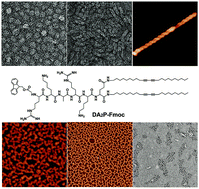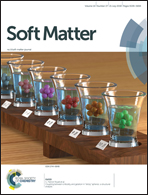Dimensional control of supramolecular assemblies of diacetylene-derived peptide gemini amphiphile: from spherical micelles to foamlike networks†
Abstract
Peptide amphiphiles capable of assembling into multidimensional nanostructures have attracted much attention over the past decade due to their potential applications in materials science. Herein, a novel diacetylene-derived peptide gemini amphiphile with a fluorenylmethyloxycarbonyl (Fmoc) group at the N-terminus is reported to hierarchically assemble into spherical micelles, one-dimensional nanorods, two-dimensional foamlike networks and lamellae. Solvent polarity shows a remarkable effect on the self-assembled structures by changing the balance of four weak noncovalent interactions (hydrogen-bonding, π–π stacking, hydrophobic interaction, and electrostatic repulsion). We also show the time-evolution not only from spherical micelles to helical nanofibers in aqueous solution, but also from branched wormlike micelles to foamlike networks in methanol solution. In this work, the presence of the Fmoc group plays a key role in the self-assembly process. This work provides an efficient strategy for precise morphological control, aiding the future development in materials science.



 Please wait while we load your content...
Please wait while we load your content...